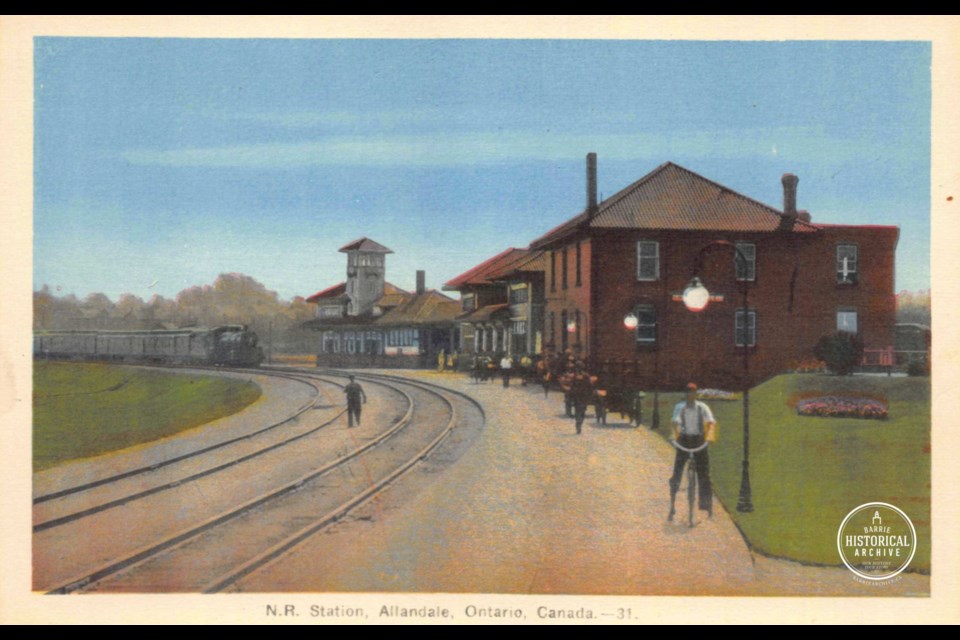This ongoing series from Barrie Historical Archive curator Deb Exel shows old photos from the collection and one from the present day.
Allandale Station
In 1847, the Barrie Magnet, Barrie’s first newspaper began advocating for a rail line between Barrie and Toronto – desperately needed to move materials and people between the wilderness of Simcoe County and the urban centres and provide an alternative to using waterways.
In July 1849, the Toronto, Simcoe and Lake Huron Union Railroad Company was formed (later renamed Ontario, Simcoe and Huron Union Railroad Company – OS & HU Railroad). Frederic William Cumberland was appointed chief engineer and general manager of OS & HU Railroad in 1852.
The first train reached the parcel of land that would eventually become the village of Allandale, on October 11, 1853.
In plotting the next leg of the of the OH & HU railway line, Cumberland determined, as did Canadian Pacific Railway later in 1906, that the best route to Collingwood, would be to head west from Allandale, by-passing Barrie and their anticipated terminal at McWatt’s wharf (Memorial Square). Barrie was devastated.
In 1857 and 1858, Barrie tried (and failed) to annex the railway lands of Allandale, anxious to control the rail yards and freight rates.
In the meantime, Cumberland had resigned in 1854 as general manager of OS & HU but was appointed vice president. Within four years the company was bankrupt and ordered closed by the government as unsafe for use. Cumberland was reinstated as general manager in 1859 and reorganized the company as Northern Railway (NR).
The first brick railway station at Allandale was constructed in 1863 by Cumberland’s architectural firm, replacing the wooden one that was built 10 years earlier.
Also in that same year, Northern was forced to build a branch line and in 1865, Barrie finally got their own switch – Station Gore (Memorial Square). In 1866, the population of Allandale was only about 150 people, but as the Northern Railway became more profitable, Allandale became more prosperous along with it and by 1872, the population has doubled.
A flurry of railways were converging in and around Allandale:
- In 1875, the Toronto, Simcoe and Muskoka Junction Railway Company completed a line from Barrie, through Orillia to Gravenhurst, bring timber resources through Barrie and Allandale
- NR took over (and finished in 1878) the North Simcoe Railway’s project to build a line from Colwell (about 5 miles west of Allandale) to Penetang that was mostly used to transport timber.
- A new line, the Hamilton and North Western Railway, between Hamilton and Barrie, scheduled to begin construction in the summer of 1874, didn’t reach Barrie until 1877. The line came in through Innisfil, heading northwest across Essa road to Vespra Street, then north east along Sophia Street over to Bayfield Street – almost like how highway 400 wraps around Barrie today. Competition, and the realization that both Hamilton and North Western Railway and NR needed to connect with Canadian Pacific Railway, led the two railways to form a new company: the Northern and North Western Railway.
- The other player was the Grand Trunk Railway (GTR), incorporated in 1852 and 1853. They experienced the same expansion and revenue challenges as many other railways and were struggling by 1861. They were also restructured and resumed buying smaller railways by the 1880’s, acquiring Northern on Jan. 24, 1888. Allandale station became GTR’s flagship of the national line.
It was GTR that built the elegant current Allandale station in 1905, following the curve of the shoreline and connecting their depot and restaurant via a breezeway to the pre-existing 2 story brick building.
Outside, it was an Italianate/Prairie School design, with a majestic tower, columns and the striking coronet-ringed waiting room with a view of the bay and incoming or departing trains.
Inside, the restaurant, which was located in the centre of the station, was divided into 2 sections: a luxurious and magnificently-appointed mahogany-paneled 60-seat dining room and a 52-seat lunch counter – both options boasting great food and service.
It goes without saying that most families in Allandale worked for or in some way provided services to one of the many railways that rolled through their village. Allandale was a true railway town.



